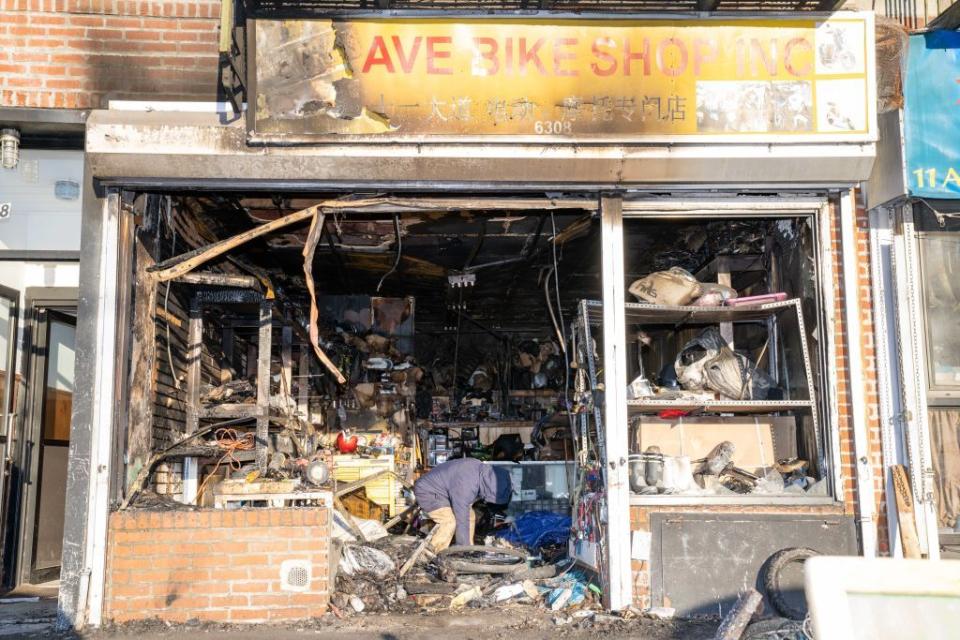Electric Car Fires Aren’t the Only Ones to Worry About

Fires started by lithium-ion batteries in Teslas, e-bikes, and scooters continue to make national news, prompting consumers to wonder if electric propulsion is unsafe.
However, firefighters and regulators say these fires often occur from counterfeit batteries and negligent charging behaviors, not an inherent defect of lithium-ion batteries.
Experts say additional regulations and industry standards, such as UL 2849 for e-bikes and e-scooters, would prevent fires and limit their severity.
Lithium-ion batteries are fueling the auto industry's conversion to battery-electric vehicles, but they've also been a catalyst in a series of transportation-related fires that have halted pickup truck production, burned down a neighborhood grocery store in the Bronx, and forced an emergency landing because of a smoking overhead bin on a commercial jet.
Fires have also allegedly been started by electric bicycle battery packs. The New York City Fire Department says lithium-ion batteries were responsible for over 200 fires within the five boroughs in 2022, resulting in six deaths and over 150 injuries while displacing thousands of residents. That's double the number of battery-related fires as compared to 2021, according to an FDNY statement to NBC News.

It's not just a problem for urban, dense cities, either. A Connecticut Transit electric bus caught fire at the agency's suburban depot in Hamden last summer, and firefighters elected to let the bus burn as the safest way to manage the blaze. Electric scooters have sparked fires and leveled homes in rural Massachusetts and Pennsylvania. Even Ford had to temporarily shut down Michigan production of its battery-electric F-150 Lightning pickup truck due to a fire in a pre-production holding lot. And how could we forget the various EV-related ship fires that ultimately scuttled the shipment of thousands of vehicles?
Analysis of fire and crash data from the Bureau of Transportation Statistics and the National Transportation Safety Board show there were 1529.9 fires per 100,000 sales for gasoline vehicles and just 25.1 fires per 100,000 sales for electric vehicles. But the bigger concern is the number of fires linked to gas-electric hybrid vehicles: 3474.5 fires per 100,000 sales.
Per FDNY Fire Marshals, the cause of today’s 5-alarm fire at 2096 Grand Concourse in the Bronx was a lithium-ion battery which powered a scooter. pic.twitter.com/HTifRojiJo
— FDNY (@FDNY) March 5, 2023
Analyzing the rate of electric car fires doesn't tell the whole story. For one, lithium-ion battery fires burn in a different way than a traditional gas fire, with the blaze lasting longer and burning hotter than a gas fire. As a result, fire departments across the globe have begun educating themselves and the public about how to deal with this new fire phenomenon. Even so, the majority of blame for these destructive fires isn't on the manufacturers of quality batteries.
In reality, uncertified batteries that are being charged without supervision or not to the manufacturer's specifications are the common thread in most of these fires. Due to the high cost of legit battery packs and the ubiquity of two-wheeled electric vehicles as urban delivery tools, many delivery workers are compelled to purchase cheaper, unregulated batteries and continue recharging them past their prime. But, as Vice President of Bosch's E-Bike division Claudia Wasko put it, trying to repair and recharge abused battery packs is a huge safety risk.

"There are different opinions and ways of certifying that the battery is a very fine-tuned high complexity system, and the ingredients are under certain circumstances flammable," Wasko told Autoweek. "Within the UL 2849 systems, you certify or pay attention to electrical shock and hazardous situations concerning the battery. The testing requirements cover any kind of system combination, and the system consists of a drive unit, the battery, the display, and any interconnecting cables."
The UL 2849 certification system is a new safety criterion from the US Consumer Product Safety Commission that covers battery electric e-bikes, e-scooters, and light electric-vehicle battery packs, and it could be a major driving force in the safe rollout of electric mobility technology. The standard classifies e-bikes by battery and drive-motor characteristics as well as sets a testing standard that requires a fire safety certification of the battery itself and in relation to other materials and components of the vehicle. The UL 2849 standard remains voluntary at this time but is intended to minimize the outbreak and the severity of lithium-ion battery fires.

Places like New York City which have been most affected by these fires aren't satisfied with this voluntary approach. As a result, the New York City Council just passed a law mandating a number of USCPSC standards by August 2023, including the UL 2849 Standard for Electrical Systems for e-bikes. This legislation could lead to increased police scrutiny of already vulnerable delivery workers while minimizing the number low-quality battery packs that have historically started fires and primarily displaced residents in low-income areas.
As politicians rush to propose bans on e-bikes and scrutinize safety standards, considering the vast regulatory apparatus that covers the automotive industry is worthwhile. Cars, and even motorcycles for that matter, have been around long enough that nearly every nation has decided on a complex and thorough set of regulations to keep consumers and the roads safe. And while e-bikes aren't exactly new, the rate at which e-bikes are evolving and proliferating means that creating regulations is a fluid task.
Too much regulation runs the risk of hindering the adoption of such versatile vehicles, while too little can lead to a culture of unsafe products and endangered populations. As with the adoption of battery-electric cars and the accompanying infrastructure, it seems that regulators and legislators will need to collaborate with manufacturers to create appropriate safety standards in addition to surveying consumers to ensure that use-ability and affordability are kept in mind. And before you lose sleep over the thought of an electric vehicle fire, remember that these fires are still extremely rare, whether you ride an e-bike or drive a Nissan Leaf.

 Yahoo Autos
Yahoo Autos 